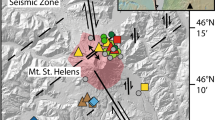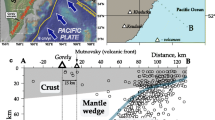Summary
Kahoolawe Island is a ∼ 1.4 to 1 Ma shield volcano composed of shield, caldera-fill, and postshield tholeiitic lavas, and postshield alkalic basalt and hawaiite lavas. One postshield vent erupted alkalic lavas (K2O 1.1–1.6 wt.%) with resorbed olivines of wide compositional range (cores, Fo86–71), resorbed Na-plagioclase (An57–30; largely andesine) and clinopyroxene (evolved; Mg#s 76–71), and groundmass orthopyroxene (Mg# ≤62). They also contain tholeiitic gabbro xenoliths, which, as a suite, have a continuum of mineral compositions — clinopyroxene Mg#s 83–74, orthopyroxene Mg#s 83–76, and plagioclase An69–35 (e.g., includes andesine gabbro). Lava compositions do not fall on expected ‘Hawaiian’ fractionation trends due to MgO ‘enrichment’ (e.g., CaO ∼ 7 wt.% @ MgO ∼6 wt.%). This assortment of mineral and rock components within alkalic lavas with apparent Mg enrichment is owed to a complex history that began with protracted mixing among primitive and differentiated tholeiitic magmas, probably near the end of shield building. These hybrid magmas crystallized a compositional variety of olivines that were resorbed during reservoir replenishments, and also crystallizedin situ to form orthopyroxene-bearing gabbro on reservoir walls. When magma production rates declined during the shield to postshield transition of tholeiitic to alkalic magmatism, the tholeiitic hybrids in reservoirs fractionated to yield highly evolved phases such as andesine and clinopyroxene with Mg# < 75. When postshield hawaiite magmas subsequently entered reservoirs, alkalic-tholeiitic hybridization occurred; the resulting `complex' mixture of hawaiite+tholeiitic hybrids resorbed andesine and clinopyroxene crystals and, upon eruption, entrained xenoliths of gabbro. Mass balancing suggests that the alkalic-tholeiitic hybridization involved ∼44% hawaiite mixed with a nearly equal amount of tholeiitic hybrid (MgO ∼9.5 wt.%) plus olivine and andesine. This type of complex hybridization is a logical process for magmatism associated with tholeiitic to alkalic transitions and waning magma production, and this Kahoolawe example is the first to document such mixing in Hawaiian reservoirs.
Zusammenfassung
Die Insel Kahoolawe ist ein ≈ 1.4 bis 1 Ma alter Schildvulkan, der sich aus tholeiitischen Schild-, Kaldera- und Post-Schildlaven, sowie aus alkalibasaltischen und hawaiitischen Post-Schildlaven zusammensetzt. Ein Post-Schildschlot förderte alkalische Laven (K2O 1.1–1.6 Gew.%) mit resorbierten Olivinen, die eine breit gestreute Zusammensetzung zeigen (Kerne, Fo86–71), resorbiertem Na-Plagioklas (An57–30; großteils Andesin) und entwickeltem Klinopyroxen (Mg# 76–71), sowie Orthopyroxen in der Grundmasse (Mg# ≤62). Sie führen auch tholeiitische Gabbro-Xenolithe, die als Suite kontinuierliche Mineralzusammensetzungen zeigen — Klinopyroxen Mg# 83–74, Orthopyroxen Mg# 83–76 und Plagioklas An69–35 (z.B. inklusive Andesin-Gabbro). Die Lavenzusammensetzungen folgen wegen einer Mg-„Anreicherung” (z.B. CaO≈7 Gew.% @ MgO≈6 Gew.%) nicht dem für Hawaii erwarteten Fraktionierungstrend. Diese Ansammlung von Mineral- und Gesteinskomponenten in alkalischen Laven mit scheinbarer Mg-Anreicherung geht auf eine komplexe Entwicklungsgeschichte zurück, die mit einer länger andauern Mischung von primitiven und differentierten tholeiitischen Magmen, wahrscheinlich im Endstadium der Schildbildung, begann. Diese hybriden Magmen kristallisierten Olivin variabler Zusammensetzung, der im Zuge der Reservoir-Auffüllung resorbiert wurde und kristallisierte an den Reservoir-Wändenin situ als Orthopyroxen-führende Gabbros. Als die Magmenproduktionsraten im Übergang vom tholeiitischen Schild- zum alkalischen Post-Schild-Magmatismus geringer wurden, fraktionierten die tholeiitischen Hybride in den Reservoiren und führten zur Bildung von kochentwickelten Phasen, wie Andesin und Klinopyroxen mit Mg# < 75. Die Zufuhr von Post-Schildmagmen in die Reservoire verursachte eine alkalisch-tholeiitische Hybridisierung. Die resultierende Mischung von Hawaiit-Tholeiit-Hybriden resorbierte Andesin- und Klinopyroxen-Kristalle und verfrachtete die Gabbro-Xenolithe bei der Eruption. Massenbilanzen weisen darauf hin, daß die alkalisch-tholeiitische Hybridisierung ≈ 44% Hawait, gemischt mit etwa dem gleichen Anteil an tholeiitischem Hybrid (MgO≈29.5 Gew.%) plus Olivin und Andesin, beinhaltete. Diese Art komplexer Hybridisierung ist ein logischer Prozeß von Magmatismus mit tholeiitisch-alkalischem Übergangschemismus und ausklingender Magmenproduktion und dieses Beispiel von Kahoolawe ist das erste, das derartige Mischungsprozesse für Reservoire auf Hawaii dokumentiert.
Similar content being viewed by others
References
Bauer GR, Fodor RV, Husler JW, Keil K (1973) Contributions to the mineral chemistry of Hawaiian rocks III. Composition and mineralogy of a new rhyodacite occurrence on Oahu, Hawaii. Contrib Mineral Petrol 40: 183–194
Clague DA (1987) Hawaiian xenolith populations, magma supply rates, and development of magma chambers. Bull Volcanol 49: 577–587
Clague DA, Denlinger RP (1994) Role of olivine cumulates in destabilizing the flanks of Hawaiian volcanoes. Bull Volcanol 56: 299–349
Fodor RV, Moore RB (1994) Petrology of gabbroic xenoliths in 1960 Kilauea basalt: crystalline remnants of prior (1955) magmatism. Bull Volcanol 56: 62–74
Fodor RV, Galar P (1997) A view into the subsurface of Mauna Kea volcano, Hawaii: crystallization processes interpreted through the petrology and petrography of gabbroic and ultramafic xenoliths. J Petrol 38: 581–624
Fodor RV, Keil K, Bunch TE (1975) Contributions to the mineral chemistry of Hawaiian rocks IV Pyroxenes in rocks from Haleakala and West Maui volcanoes, Maui, Hawaii. Contrib Mineral Petrol 50: 173–195
Fodor RV, Frey FA, Bauer GR, Clague DA (1992) Ages, rare-earth element enrichment, and petrogenesis of tholeiitic and alkalic basalts from Kahoolawe Island, Hawaii. Contrib Mineral Petrol 110: 442–462
Fodor RV, Rudek EA, Bauer GR (1993) Hawaiian magma-reservoir processes as inferred from the petrology of gabbro xenoliths in basalt, Kahoolawe Island. Bull Volcanol 55: 204–218
Fodor RV, Jacobs RS, Bauer GR (1994) Hollandite in Hawaiian basalt: a relocation site for weathering-mobilized elements. Mineral Mag 58: 589–596
Helz RT, Wright TL (1992) Differentiation and magma mixing on Kilauea's east rift zone. A further look at the eruptions of 1955 and 1960, part I. The late 1955 lavas. Bull Volcanol 54: 361–384
Keil K, Fodor RV, Bunch TE (1972) Contributions to the mineral chemistry of Hawaiian rocks II. Feldspar and interstitial material in rocks from Haleakala and West Maui volcanoes, Maui, Hawaii. Contrib Mineral Petrol 37: 253–276
Leeman WP, Gerlach DC, Garcia MO, West HB (1994) Geochemical variations in lavas from Kahoolawe volcano, Hawaii: evidence for open system evolution of plumederived magmas. Contrib Mineral Petrol 116: 62–77
Mangan MT, Marsh BD (1992) Solidification from fractionation in phenocryst-free sheetlike magma bodies. J Geol 100: 605–620
Mansker WL, Ewing RC, Keil K (1979) Barian-titanian biotites in nephelinites from Oahu, Hawaii. Am Mineral 64: 156–159
Marsh BD (1989) Magma chambers. Ann Rev Earth Planet Sci 17: 439–474
Marsh BD (1996) Solidification fronts and magmatic evolution. Mineral Mag 60: 5–40
Moore JG, Clague DA (1992) Volcano growth and evolution of the island of Hawaii. Geol Soc Am 104: 1471–1484
Rhodes JM (1995) The 1852 and 1868 Mauna Loa picrite eruptions: clues to parental magma compositions and the magmatic plumbing system. Am Geophys Union Monog 92: 241–262
Rybek I (1995) Petrology of shield-building, caldera-filling, and postshield basaltic rocks, Kahoolawe Island, Hawaii. Thesis, North Carolina State University, 56 p
Spengler SR, Garcia MO (1988) Geochemistry of the Hawaii lavas, Kohaha volcano, Hawaii. Contrib Mineral Petrol 99: 90–104
West HB, Gerlach DC, Leeman WP, Garcia MO (1987) Isotopic evolution of Hawaiian mantle sources: evidence from the Maui volcanic complex, Hawaii. Nature 330: 216–220
West HB, Garcia MO, Frey FA, Kennedy A (1988) Nature and cause of compositional variation among the alkalic cap lavas of Mauna Kea volcano, Hawaii. Contrib Mineral Petrol 100: 383–397
Wright TL, Fiske RS (1971) Origin of the differentiated and hybrid lavas of Kilauea volcano, Hawaii. J Petrol 12: 1–65
Wright TL, Helz RT (1996) Differentiation and magma mixing on Kilauea's east rift zone: a further look at the eruptions of 1955 and 1960, part II. The 1960 lavas. Bull Volcanol 57: 602–630
Yang HJ, Frey FA, Garcia MO, Clague DA (1994) Submarine lavas from Mauna Kea volcano, Hawaii: implications for Hawaiian shield stage processes. J Geophys Res 99: 15577–15594
Author information
Authors and Affiliations
Additional information
With 8 Figures
Rights and permissions
About this article
Cite this article
Fodor, R.V., Bauer, G.R. & Jacobs, R.S. Alkalic magma modified by incorporation of diverse tholeiitic components: ‘Complex’ hybridization on Kahoolawe Island, Hawaii. Mineralogy and Petrology 63, 73–94 (1998). https://doi.org/10.1007/BF01162769
Received:
Accepted:
Issue Date:
DOI: https://doi.org/10.1007/BF01162769




